
As an industrial design graduate from the London School of Art and Design, Tim Heywood was awarded a scholarship from the Royal Society of Art, which enabled him to get up close and personal with car manufacturers. After visiting a few, he realised that he would initially only design tail lights and door handles. The car option was ruled out. While looking for a job in London, someone referred him to an acquaintance who "works in Chelsea and designs boats. You should look him up!" Tim rang Jon Bannenberg and was asked to come round the next day. He stayed up all night drawing yachts - the longest was six metres long. Tim Heywood says of his interview at 6 Burnsall Street: "He gave me the job!"
I personally remember Tim, or rather a man with a moustache, who was very busy when I visited Jon Bannenberg's studio in 1987. Tim had been working there for 15 years by then and after ten more Bannenberg years opened his own office. By the time Tim Heywood Designs (THD) had become an established studio, I had put any ambitions as a designer to one side and was working as editor-in-chief of a yachting magazine. Our paths crossed again and again at trade fairs and parties.
I found Tim to be a consistently polite, level-headed and impeccable conversationalist who puts a witty spin - or a new twist - on any design discussion. When I showed him the idea for a yacht designer software called DesignAnswers, he suggested that the name DesignQuestions would be better, as having all the answers online would probably sound far too simplistic.
Yacht design in the castle
I had heard from his friends that Tim lived in a castle in Rutland with his partner and business partner Vanessa, and I was looking forward to travelling there for this article. But five years ago they moved to Hampshire in the south of England. As they were both suffering from a Covid infection, they rightly didn't want to receive a journalist from London in person. The virtual meeting via Teams began, and my first question was about the castle, which is definitely worth a Google search.
"We lived in a very large house called Burley-on-the-Hill, which was built for the Duke of Buckingham in 1620. We lived in the east wing. The problem with this beautiful property was that there were 86 steps between the office - which was in the basement - and the bedroom. We had a standing height of six metres in the lounge and dining room. I worked until late and then went to bed, but on the way to the bedroom I had so much oxygen that I woke up again! Five years ago we decided to move back south to be with family and bought this house in Hampshire. It was a big project, but I'm pleased to say it's now finished."
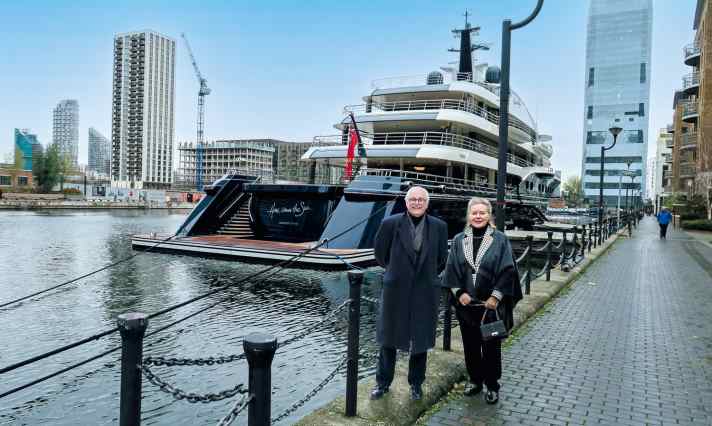
One-man and one-woman operation from the manor house
This BOOTE EXCLUSIVE studio portrait is not illustrated as usual with photos of offices in which a large number of designers are sketching in the background or looking intently at a monitor. For one simple reason: Tim Heywood Designs has no employees. It's a one-man, one-woman operation that has, incredibly, moulded 66 superyachts (in addition to the 22 at Jon Bannenberg). When I asked him about the fact that he must outsource a lot, he replied: "The only thing I outsource is the modelling" (to David Fawcett).
Tim Heywood is known today primarily as a line designer. What about interior design? "I used to do interiors, and I enjoyed it, but when we started working on big projects in 2001 - 'Pelorus' was the start - I realised that we would either have to change the way we worked or change the studio, as it was just Vanessa and me. Designing the interior of a 115 metre yacht involves an astronomical amount of work. Talking to the client, who previously had a yacht with a Terence Disdale interior, he suggested to me: 'Would it be a good idea to work with Terry?' and I said: 'Yes, I've known Terry for a long time'. We sat down together and decided that the rubber seals on the doors should form the demarcation line. The inside was Terry's and the outside was mine. That worked very well and I made the same kind of informal agreement with Andrew (Winch Design) and many other designers, probably nine by now. Laura Sessa is another designer we've worked with a lot because of our work at Amels."
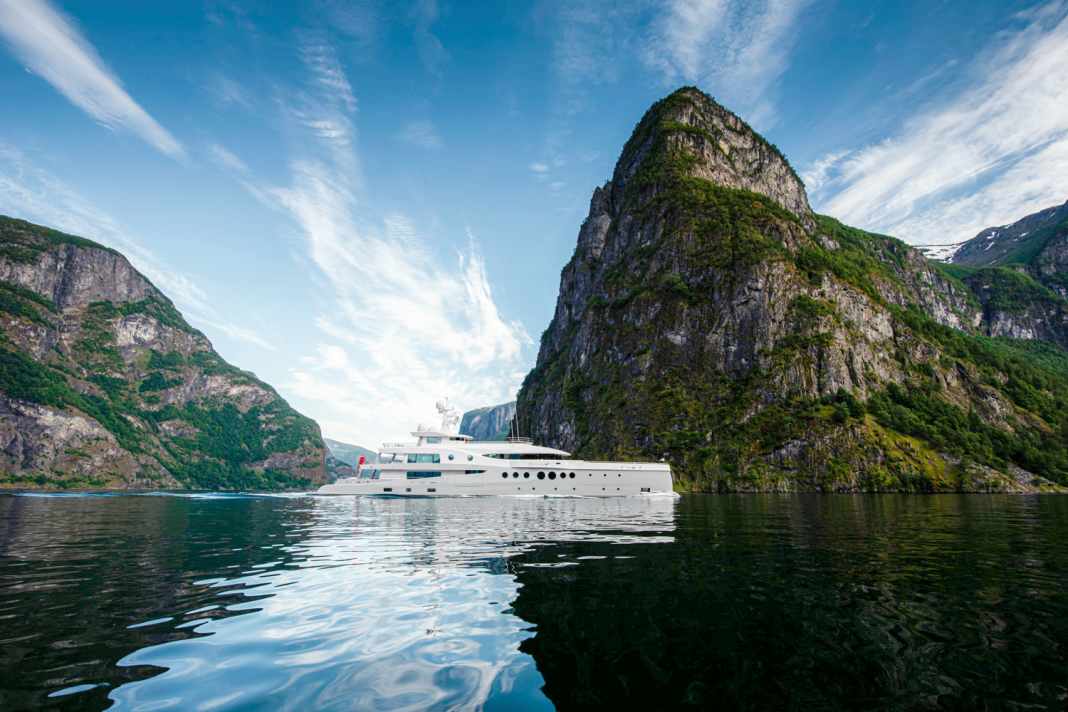





From Jon Bannenberg to independence
Given that it was every designer's dream to be part of Jon Bannenberg's team in the 1980s, it must have been a difficult decision to leave him. But Tim and Vanessa made it: "Yes, it was quite a blow, but I had worked with Jon for over 20 years and I really enjoyed it. Jon gave me a lot of freedom, which I really liked. We got an enquiry from a potential client, who I met with and explored a collaboration. When Jon then said: 'I'm busy in Australia, you deal with it', I did all the client meetings and yard meetings, and Jon came round once or twice during the build and said: 'Tim's doing a marvellous job', then he went back to Australia. Jon was travelling quite a lot as he was in charge of all the Oceanfast projects."
Vanessa said to Tim: "If you want to start your own business, I'll help you for a year." It turned out to be 27! They had a flat in Wapping (London) at the time, and Vanessa suggested that they didn't need an office and could work from the flat. Tim started explaining the layout to me: "The first room you walked into was the living room, so we turned it into an office and made the second bedroom into the living room. That way, Vanessa could close the door to the office at 6pm in the evening. That worked well and after a while we decided to move out of London because 99 per cent of our clients didn't come to our studio, we went to them. So we decided to look for something out of the ordinary and we found this place in Rutland."
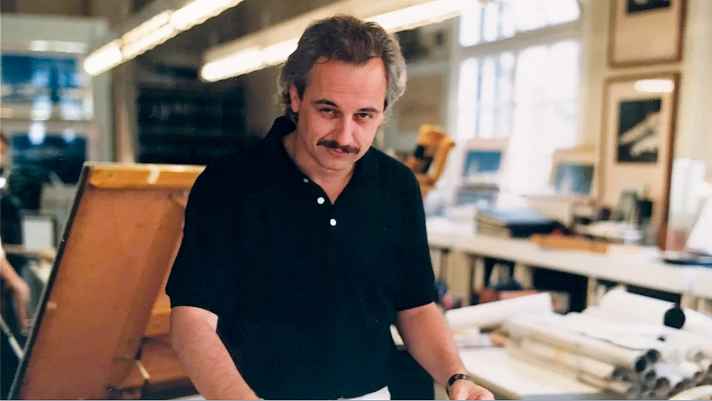
Having just received a lifetime achievement award, I asked him what was next. "I've just turned 72. I thought I needed to slow down and that's what I tried to do. One of the benefits of Covid was that Vanessa and I both caught it at the beginning of 2020 and couldn't work for almost four months. That forced me to slow down and I've managed to do that since then! I still have four or five boats under construction, but many of them are limited edition Amels models that don't involve too much work. This morning I chose the materials for the worktops for the cabinets on the outside decks."
Magnificent private jet interior and order in Hamburg
Many designers in his guild are also active in other areas, so I asked Tim about design work that has nothing to do with superyachts. "I have a very nice non-yacht project in Germany that I'd rather not say more about at this stage, but I'm really enjoying it. It's in Hamburg, a beautiful city." Tim adds casually: "Oh, I designed the interior of a Boeing 737-400 for a yacht owner, that was at Lufthansa Technik. I'd known the client for a long time - I was the project designer at Bannenberg for his yacht, and then when I left Jon, this client commissioned me to do several other things, including extending the existing yacht and designing his aircraft, one of the most opulent ever built. His yacht, 'Siran', was just as opulent."
Jon Bannenberg also gave him a commission for yacht illustrations and wanted him to complete the "Limitless" project for him at Lürssen. Which he happily did, taking on the design responsibility for all crew areas. "A few years later, I modified the finished yacht by adding a gym to the upper deck, extending the superstructure and installing additional crew cabins on the lower deck." The first projects that also bore his name were "Pelorus", "Carinthia VII", then the refit and extension of "Siran" at Feadship in Makkum - what a start! He had worked there on several projects when the shipyard still belonged to Amels. After Amels sold it to Feadship and moved to Vlissingen, 45 Amels yachts were built there according to THD designs
Sources of inspiration for scimitar and waistline
Many design studios boast that they don't have their own style and that they adapt to every client. Tim is quite proud of the THD style - although there are variations - and describes it as follows: "Athletic feminine, that's how most of our yachts are, with sort of tight curves." Then there was another boat he drew for Amels, which started out as 199 and is now called 206. "Build number one was called 'Event' and has what I call a crook. It's out of line. The design is masculine and has a slightly military touch. That was something I was very happy about and am still very proud of." Tim Heywood developed two Steven variants. The first design he presented had a typical clipper bow, and then he said to the Amels people, "If you really want to push the envelope, you should build this," and he showed them exactly the same drawing, but with the crook. They thought it was a completely different yacht because it changed the look so much.
What inspired him to create this unusual design? "Most of my inspiration came from military boats as they existed 100 years ago. For 'Pelorus', I developed the so-called 'waistline', a curve that runs along the side of the hull and slopes down towards the bow. This was inspired by the 'HMS Belfast', which is now a museum ship in London. She has armour on the side of the boat that slopes down towards the front, giving the hull extra thickness. I liked that and made the step a smooth transition, which became a sort of distinguishing feature of some of my designs."
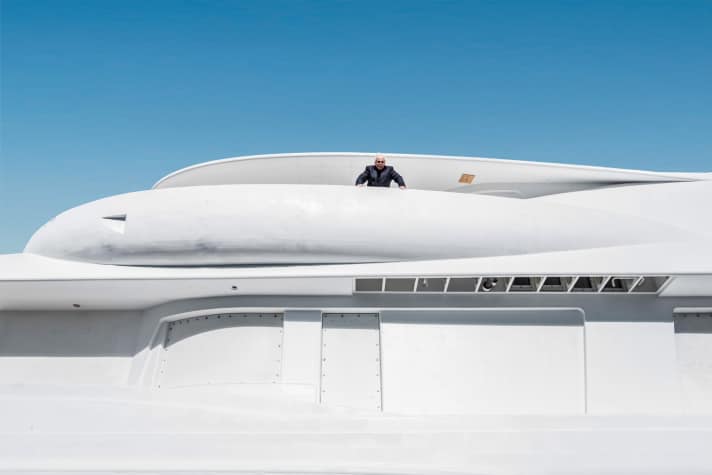
Fees, brokers and the Bannenberg University
I have never had a designer answer the question about fees for yacht designs. Tim Heywood didn't want to give any figures either, because it's always something you have to think about very carefully. "You look at the size of the boat, of course, because the bigger the boat, the more work is involved. You estimate the time you have to invest. There are people who say: 'I want to build a yacht, maybe we'll go to a shipyard next year': 'Well, yes, sir!' There are others - a customer came to me and said: 'We need a design, I have signed a contract with a German shipyard to build a yacht to your design'. I asked him when he needed the design by. He replied: 'I told the shipyard that we'd have it in a month!"
What about working with brokers? "Since I left Jon, there have been brokers who say: 'Can you do a concept design for us? We have a client who is very serious,' and since I was trained at Bannenberg University, I say, 'Yes, yes, of course I can do that: 'Yes, yes, of course I can do that, but first I'll send you my fee overview for creating the concept - that will definitely separate the wheat from the chaff.' So when I'm asked whether I can present a concept, I say: 'No, because all my concepts have been paid for by clients and are subject to confidentiality. That has helped me a lot not to waste time."
How the design of a superyacht works
The design process for a superyacht begins with a meeting with the future owner. Tim Heywood wants to find out what he really wants from the yacht and how it should be constructed. This is because he always determines the layout. "The exterior must be centred around the GA plan and include it. It is very important to find out from the customer what style they like. They will probably be inspired by one of my boats, otherwise they wouldn't come to me. I create a concept sketch and a GA sketch, meet with him again and say: 'This is the way I want to go. Can you think about it and make a few comments? A lot of clients will say: 'Yes, let me think about it.' I then say: 'Wait a minute, we're sitting here together now, let me go through the interior with you'."
In this way, Tim Heywood gets owners to concentrate. And because he always has a sketchpad and pencil with him, he can immediately sketch an alternative floor plan, for example of the master suite. "You have to keep up the pressure so that the design is actually created in the time available. Based on the sketches I've made in the meantime, I then go back to my studio and transfer everything into a more solid form using a computer drawing programme. As soon as the owner has given his approval, I can send these drawings to the shipyards so that they can submit an offer."
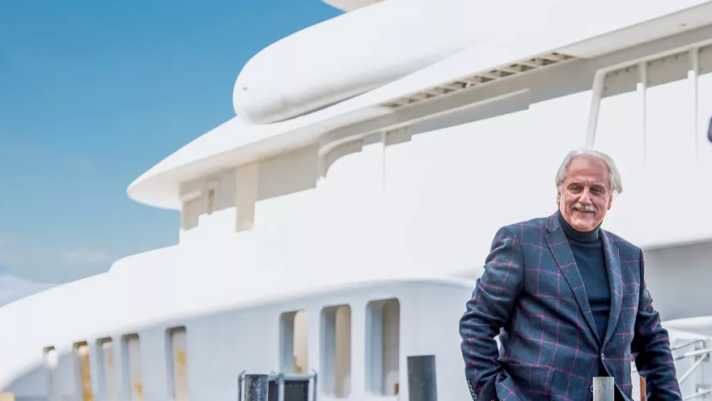
Oversized curve rulers and ellipses
Something I've always wondered is whether Tim creates his famous curves using straightedges and pigs. "I do everything by hand, then scan it, jerk it and smooth it out. I never had weights and pigs myself. We worked with them in the early days at Bannenberg. Over the years, I've discovered a set of oversized curve rulers that I use regularly. Then I figured out how to construct ellipses where the curves are part of the ellipse and created a table of offsets that tell the yard: this curvature starts at ten degrees from the horizontal of the ellipse and then runs to the horizontal. This corresponds to an ellipse of 23 by six metres, which defines the curvature.
At that time, the shipyards were starting to use more and more computers, but I found that each shipyard I worked with used a different computer system and different programmes, and had even written their own programme. Fortunately, they import my programme and use it to create their technical drawings, which I then check. I also attend meetings at the shipyard and sit down with the 3D modellers, who then create 3D models under my guidance." I note that you have to be flexible when drawing equipment such as the domes for satellites, as technology can change during a five-year planning and construction period. "Whatever you draw now is likely to change before it's bolted to the superstructure." When asked the ubiquitous question of what mega and gigayachts must have these days, it is confirmed that lifts (every THD vessel over 65 metres), beach club areas to get close to the water, a gym, sauna, hammam, disco or a hairdressing room are mandatory. Tim joked: "We already had a hairdressing salon on 'Nabila' in 1853!" The ship was actually launched in 1980.
Semi-retirement and trophies as doorstops
Will Tim Heywood continue to design? "When nice projects come my way, I will seriously consider them. I like to work with clients I already know. I have quite a long list, and I tend to favour owners like that over weird, crazy guys who have made a lot of money and we don't know how. I could sit back and relax, but it's nice to have something to do. I'm very happy with the work I'm doing at the moment."
The question of a favourite design is difficult, but groundbreaking designs are easier: "The most groundbreaking project was 'Pelorus'. It established me at the top of the industry after I left Bannenberg. People asked me: 'You left Bannenberg, what are you doing? 'I can't say. Three years later, 'Pelorus' came out. Actually, 'Carinthia VII' was launched first, but it was designed after 'Pelorus'. Both have a special place in my heart." And what does he do with all the trophies? "I have to say, they make fantastic doorstops!"
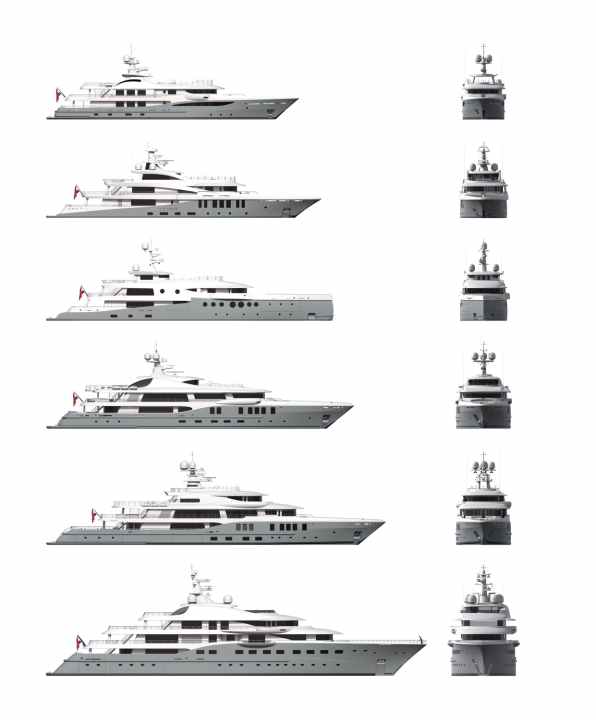
Successful oeuvre
Tim Heywood moulded 45 superyachts for Amels alone. A total of 25 (!) units of the 55 metre long Amels 180 (formerly 171) have been delivered since 2007. This is probably an absolute record in this semi-custom size segment. Seven units of Heywood's 74-metre Amels 242 platform are already afloat, with another under construction. His personal favourite is the Amels 206 (previously 199), his latest design commissioned by the shipyard is the Amels 200. In total, Tim Heywood Designs - the British designer runs the studio together with his wife Vanessa - is responsible for the exterior design of 66 yachts, eight of which are Lürssen formats, and ten tenders.

